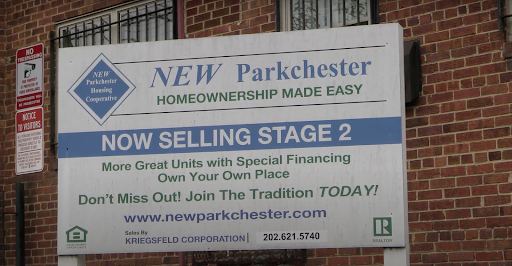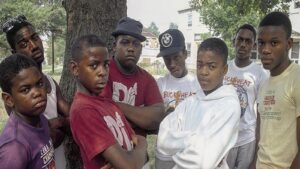By Autumn Coleman, Jakeria Haynes and Hunter Stevens
Today, like every day for the past 10 years residents of Barry Farms are being pushed out.
The Barry Farms neighborhood is located in Southeast Washington, D.C. – which to D.C. natives is known as “east of the river.”. The neighborhood originated as a development established by the Freedmen’s Bureau for housing freed Black people after the Civil War. It was known then to house a powerful Black political class, including abolitionist Frederick Douglass. Today, developers like Community Three Development, Bogdan Builders and Abdo Development are pushing out residents across the DMV area in service of gentrification. The majority of these neighborhoods are historically Black.
Moe Shorter, manager of the go-go group Junkyard Band which originated in Barry Farms, says that the myth that modernizing equals improvement is just that – a myth.
Shorter says before gentrification, Barry Farms was a unified neighborhood.
“As a kid, there were open fields to play in,…There was a recreation center to go to… and that’s one of the things that unified the community. The town was a lot less dangerous than it is now. It was all fun, no violence, and everything was good,” Shorter remembers. “Now, more dangerous, yet ironically more gentrified than ever before. The people of the neighborhood are being forced out of their homes.”
Today, residents have been promised relocation and return by the Preservation of Affordable Housing organization but this has yet to happen, calling into question the motives of all parties involved. Residents who have been lucky enough to keep their housing are still unsatisfied with the service from Kriegsfeld Corporation, a company behind new developments in the community.
Barry Farms resident, Rumon Toatley says “The inadequate and unethical practices that are going on in this condo…the infrastructure is damaged and its been damaged for a while,” in reference to his building. “They cut the gas line and didn’t notify the building’s residents. We had to evacuate on multiple different occasions.”
Toatley says his building’s investor, Kreigsfield Corporation, “put cheap infrastructure in the building.” Citing his mounted TV that fell from a lack of studs in the wall as evidence.
Historically, Barry Farms residents are no stranger to outsiders encroaching on their homes, sparking generations of resistance.
In the early 1900s, D.C.’s government planned to build a sewage pumping station at Poplar Point. This project would take land from Barry Farm residents. The government attempted to buy the properties from owners, but couldn’t agree on a price. In 1903, instead of coming to a compromise, the government sued the residents who were in the way of the project to have their properties condemned. Their land and houses were seized through eminent domain.
Although the town is facing challenges outside of its control, residents continue to hold its historical significance near and dear to their hearts.
Housed in Ward 8, Barry Farms is rich with D.C.’s culture, specifically D.C.’s distinct Go-go music sound. In 1980, the child residents of Barry Farms formed the Junkyard Band. Their instruments consisted of soda bottles, tin cans, and anything else they could get their hands on.
The spirit of the band came from the music programs being taken out of the local schools. Taking matters into their own hands, the young people of Barry Farms began creating music from found objects. Their sound grew to be synonymous with the sound of D.C.
The band began performing around the D.C. area and eventually caught the attention of Def Jam Records. In 1985, the group was signed to a multiyear recording label allowing them to work with many big names. Including Lauryn Hill, Tupac, and Ice Cube. The band’s influence led to Mayor Muriel Bowser proclaiming January 15 as Junkyard Band Day.
The Junkyard Band’s success represents the retention of culture in the community even through gentrification, and developmental plans have changed the dynamic in the community.
“Go-go is a mainstay of this city,” says Shorter “Go-go has not changed. We’re holding on to it and we’re not going to let them take it from us,” he says about the music’s importance to D.C.
There is a rich history of community and resistance in Barry Farms and the culture that has come out of it reflects that. While DC’s larger community recognizes the rich cultural history of Barry Farms, developers don’t share the same interest. City leaders have been working to uphold the community’s customs.
Maurice Mackmorrow, a Community Life Coordinator in a Barry Farms apartment that has displaced residents, has worked to recover the community, especially those who were displaced. He explains a system that has been created to help those who have been displaced by receiving “a federal voucher, housing voucher that they can move anywhere in the United States.” The coordinator says that the building has rehoused around 30 inhabitants, who are starting to transition out of Barry Farms using those government-given vouchers.
While Mackmorrow does what he can to help, he describes why it could be hard to keep culture alive in Barry Farms: lack of mentorship. “That’s what hurts this area, too, with mentorship programs and after-school programs because the money is not on this side,” Mackmorrow says.
According to the Office of Juvenile Justice and Delinquency Prevention, federal funding, and out-of-pocket donors are the main contributions to funding mentorship programs. In the Barry Farms area, “…people are strapped all the way around. Everybody is one paycheck away from being on the street,” he explained.
If there is no unity in the community, then it’s just a neighborhood,” said Mackmorrow about preserving culture and therefore, the community. “Times have changed, and I believe social media has a lot to do with it… the displacement of our folks because we’re always putting things out and telling about the bad things, but we never share-focus on the positive things that are going on in our neighborhood.”
Community leaders seek to build Barry Farms back up from its fragmented community. But acknowledging the history shows the complexities of their feat.
Speaking on the recent history of gentrification in D.C. and Barry Farms, Moe Shorter shared, “These people had their bright idea to bring more people in but it started changing the landscape of the city thus gentrification began in DC. Lots of people were being moved out and displaced and we as native Washingtonians started to feel uncomfortable in our city and that’s a very unfair position to be…people felt threatened and you see some of those reactions from people when they rob and steal from certain people.”

